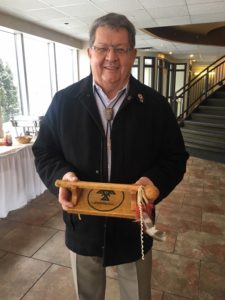Opinion: The Anishinabek Nation War Club and the Crown’s Loyal Witness

By Dorothee Schreiber
The Anishinabek Nation war club showed up in court Mar. 7 for the cross-examination of Canada’s witness in the Robinson Treaty annuities case. The club was at the table with Joe Arvay, legal counsel for the Huron plaintiffs, as he dissected the evidence of Alexander von Gernet.
Mr. Arvay: “You use as an example…the Anishinaabe culture can be demonstrated to have changed because an Anishinaabe person today wouldn’t bring a ball-headed war club with scalps to a meeting with the Governor General. Is that a very good example of how a world view changes within a culture?”
Dr. von Gernet: “… In this instance it’s a difference in an actual behaviour, which in turn is a difference in the entire orientation that one has to the world…When behaviours change, it’s generally a result of beliefs that change.”
…
Mr. Arvay: “Doesn’t the club…provide some kind of metaphor or symbol for the nature of the relationship, this nation-to-nation relationship that the First Nations had with the British, and what they did for the British as part of that relationship?”
Canada’s use of Dr. von Gernet as an expert witness does real damage to what should be a respectful relationship between the treaty partners. Von Gernet gave evidence to defend Canada’s position against Indigenous peoples in major cases such as Daniels (2013), Tsilhqot’in (2007), Samson (2005), and Benoit (2003). In the Robinson Treaty annuities trial, he again played his now familiar role – testifying that oral histories can’t be relied upon for information on how the Anishinabek approached treaty-making in 1850.
Von Gernet refers to himself as an ethnohistorian, but he has never conducted oral history research with any First Nations community, nor published any peer-reviewed articles on oral history. He is an outsider to the scholarly community of ethnohistorians in Canada. That hasn’t stopped the Crown from hiring him numerous times to write expert reports on First Nations from British Columbia to the Prairies to eastern Canada.
Von Gernet likes to dress up his testimony with a lot of fancy language, using words like “Weltanschauung”, “raconteur”, and “semiotics,” when “world view”, “storyteller”, and “symbolism” would do just fine.
As Dr. von Gernet admitted in court, the basis of his knowledge of Indigenous law is what he learned in the 1970s as an undergraduate: “all Indigenous peoples tended not to draw a firm line between the secular and the sacred and also did not draw a firm line between humans and other-than-human beings.” He doesn’t think oral histories can be used to understand Anishinaabe principles of justice and treaty-making, like respect, reciprocity, and renewal because those are universal principles that all people in the world share.
This is where Mr. Arvay sliced right through Dr. von Gernet’s superficial approach.
Mr. Arvay: “Let’s take the words that we as lawyers are familiar with: equality, freedom, liberty, justice. Those are very general words, aren’t they?…And you might appreciate that those very words are found in constitutions in other countries in the world…And they are very general words yet in the hands of experts, whether it’s lawyers or judges, they take on a particular meaning…Even as between Canada and the United States where the societies are somewhat similar, those words have taken on different meanings, even as between our two countries…And if I tell you that some of those very same words are in constitutions of some very undemocratic countries, such as Russia and China, they mean very different things altogether, would you accept that?…But no one says that those words do not purport to reflect the laws of those countries or can be disregarded because they’re too general, do you appreciate that?…Maybe, Dr. von Gernet, the problem is you as an anthropologist aren’t comfortable with legal principles that are general, but everybody in this room is very comfortable with them…You’re looking for documents…things that archaeologists find, that you can find in the ground…Your problem with what she [Dr. Heidi Stark, an Anishinaabe scholar] did is that her legal principles in your view…were susceptible to multiple meanings, but as a legal scholar, that’s not something that troubles us…It’s the nature of legal principles. They are susceptible to multiple meanings. They require expert interpretation.”
Dr. von Gernet has trouble with the concept of Indigenous law as a factor in the making of the Robinson Treaties because he doubts that Anishinaabe knowledge systems could have survived into the 19th century. He believes that by the 1830s and 40s, Anishinabek were taken over by Christianity and the “practical implications” and “stark reality” of settlement – though he thinks some individuals may have held on to their beliefs.
Anishinaabe legal scholars, von Gernet believes, cannot be trusted to study past Anishinaabe legal regimes because these scholars “are part of a modern educational system that has encouraged the Indigenous peoples to adopt a kind of western intellectual framework and study Indigenous cultures through that framework.”
For von Gernet, tradition appears to be a zero-sum game where adopting elements of the “modern” is a loss of tradition in equal measure. It seems impossible for him to imagine that the Anishinabek were engaging with European ideas and practices, while also inviting the newcomers to share in an Anishinaabe legal order. Shingwaukonse, like other Anishinaabe leaders of the time, was rooted in traditional ways but open to working with new industries and the Crown to ensure that Anishinaabe values and law would endure into the future. This approach only strengthened and renewed Anishinaabe ways of knowing.


